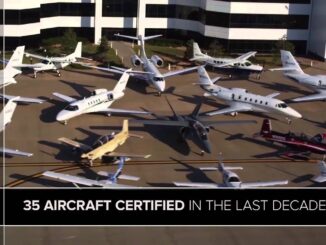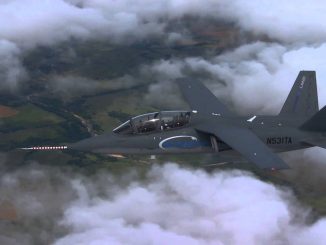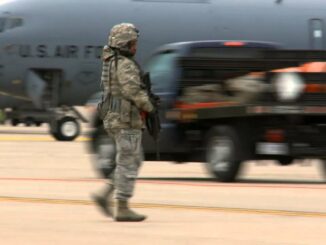The history of Forbes Field AKA- Forbes AFB, KS
55th Strategic Recon Wing, 1370th Predecessor 1370th Photo Mapping Wing Patch Aerospace Cartographic and Geodetic Service Patch
Story from The Topeka Capital-Journal
TOPEKA, Kan. — We will never know just who was responsible, but detailed plans for the Topeka Army Air Field(TAAF) clearly were complete and waiting in someone’s Washington, D.C., office long before Japan attacked the United States. Congress authorized the massive building project within two weeks after the Dec. 7, 1941, attack on Pearl Harbor. Eight months later, the completed air base — ready right down to essential buildings, hangars, repair shops, steam heating plants, fuel storage and three 7,000 by 150-foot paved runways — was formally accepted by the Army Air Corps.
August 1942 — The first troops arrived and had to be quartered in the agriculture building on the Topeka Fair Grounds because their green wood two-story barracks buildings weren’t finished yet. By September, the field was the home of the 333rd Bombardment Group.
February 1943 — The base was transferred to the 21st Bombardment Wing, and the air field’s job shifted from training new crews in flying four-engine bombers to preparing crews and new bombers for the long trans-Atlantic flight to England.
1945 — TAAF became one of three B-29 centers, where newly transitioned crews claimed new Superfortresses and took off for the Pacific to aid in the assault on the Japanese home islands.
March 1945 — Fighter pilots and tow target personnel began to stream through TAAF to claim their airplanes.
August 1945 — Command of the base shifted from the 21st Bombardment Wing to the 1st Staging Command, and beginning in October emphasis was placed on shipping ground personnel overseas rather than flight crews. Some 2,000 men were sent to TAAF to be processed as overseas replacements. That project was completed in February 1946 by ATC.
Nov. 28, 1945 — Air Transport Command took over the field, and in December nine C-47s, 80 pilots and copilots and other equipment were moved to TAAF from Fairfax Airport in Kansas City, Kan. TAAF became the only mid-continent stop for ATC’s daily transcontinental VIP flight between Washington, D.C., and Hamilton Field, Calif. Soon it also hosted two other daily shuttle flights.
January 1946 — TAAF became a refueling point for the new jet planes. Starting that month, TAAF played a major role in ferrying 1,300 military planes to 40 air fields throughout the United States and in a project for delivering 2,600 others to reserve units around the country.
August 1946 — TAAF became home to ATC’s Northwestern Sector Headquarters, which coordinated U.S. Army Air Forces Air Transport Command operations from 14 bases.
September 1946 — Congress slashed military appropriations, military and civilian personnel numbers plummeted almost overnight, and base activity was cut drastically. Topeka remained an ATC air terminal and operating base, but most transport crews were transferred and several flights discontinued.
October 1946 — ATC began transferring surplus Douglas C-54s here for storage.
November 1946 — Topeka was designated a separation center for both officers and enlisted men. Air Reserve activity started here the same month, but was discontinued in March 1947.
December 1946 — TAAF took part in “Operation Santa Claus,” flying hundreds of amputees and litter cases from Army hospitals home for Christmas. Also, from December 1946 to February 1947, the base trained 26 Portuguese Air Force personnel in air-sea operations using B-17s and C-54s.
March 1947 — Northwestern Sector Headquarters closed.
Oct. 31, 1947 — TAAF inactivated.
July 1, 1948 — TAAF reactivated as a Strategic Air Command base(SAC); home to the 311th Air Division, Reconnaissance, and to the 55th Strategic Reconnaissance Wing. That mission continued until Oct. 14, 1949, when the base was again inactivated. During that activation, TAAF was renamed Forbes Air Force Base in memory of Maj. Daniel H. Forbes, a Topeka pilot killed June 5, 1948, while testing the Northrop XB-49 “Flying Wing” jet bomber near Muroc Dry Lake, Calif.
Feb. 1, 1951 — During the Korean War, Forbes AFB reopened and was again assigned to SAC.
Feb. 16 — The 21st Air Division was activated at Forbes, and the division’s 90th Bombardment Wing moved to the base in February and March. The wing trained SAC’s newly activated 376th, 308th and 310th Bomb Wings. From June 1951 to August 1953 it also trained B-29 replacement crews for combat. About 10 a month were trained until August 1952 when the bomb wing training program was concluded and the number of B-29 crews produced was doubled.
June 16, 1952 — The 90th was redesignated the 90th Strategic Reconnaissance Wing, Medium, and five months later started training recon crews as replacements for Far East Air Forces.
October 1952 — The 55th Strategic Reconnaissance Wing moved to Forbes from Ramey AFB, Puerto Rico, continuing its program of photography, photomapping and electronic reconnaissance.
August 1953 — The training mission terminated. The wing had started to develop its own capacity for reconnaissance operations earlier, and spent the rest of 1953 training its crews in refueling operations required for strategic reconnaissance.
February 1954 — The base acquired 528 more acres of land and Congress approved construction of a 12,000-foot runway to accommodate Boeing RB-47 jets. The 90th Wing began converting to RB-47s in March 1954 and the 55th in June 1954. Thereafter, both wings trained to combat readiness at Forbes. After they were declared combat ready, both units began temporary overseas duty tours but returned to Forbes for continued training each time. By the end of 1954 both wings had phased out their piston-engine RB-50s. The 55th started transitioning into the RB-47 in September 1953, the 90th in February 1954.
June 1955 — The 21st Air Division and subordinate units were assigned to Eighth Air Force, when both wings’ refueling missions were assigned. The 90th Air Refueling Squadron was activated in August, the 55th ARS in October. Both squadrons received KC-97s — large-bodied transport derivatives of the B-50, which in turn was a slightly improved B-29.
1958 — 650 units of family housing were built on 160 acres west of US-75; first phase of the Capehart housing development known as Cullen Village by the USAF and Montara by its current civilian owners. Another 414 units were constructed on an adjoining 118.75-acre tract in 1960. In addition, three “other” family units (relocated farm houses) were placed on six acres northeast of the Capehart area while another farm house and five military construction projects were built on three acres near the base hospital, in the cantonment area east of US-75.
January 1959 — The 21st Air Division and subordinate units were reassigned to the 2nd Air Force, thus completing a cycle of SAC’s three numbered air forces within the continental United States.
February 1959 — SAC announced Atlas intercontinental ballistic missile sites would be constructed around Forbes.
In June 1960 the 90th SRW was deactivated and replaced by the 40th Bomb Wing, transferred from Schilling AFB, Salina.
July 1, 1960 — A Soviet MiG-15 fighter shot down a 55th SRW RB-47H in international airspace off the Russian coast north of Norway. The pilot, Maj. Willard G. Palm, and three electronic warfare officers — Maj. Eugene E. Posa and Capts. Oscar L. Goforth and D.B. Phillips — were killed. The copilot, Capt. Freeman B. Olmstead, and navigator, Capt. John R. McKone were rescued by a Soviet fishing boat and imprisoned for six months on spying charges.
Oct. 16, 1961 — Air Force Systems Command handed the nine completed Atlas ICBM complexes over to SAC. The 548th Strategic Missile Squadron became the USAF’s first to declare the Atlas “E” operationally ready.
Aug. 31, 1964 — Tactical Air Command’s 313th Troop Carrier Wing came to Forbes.
March 1965 — Its 29th Troop Carrier Squadron became the first combat-ready unit of Tactical Air Command at Forbes. It immediately assumed a rotational commitment to Panama. The whole wing was declared operationally ready in June, and in July “ownership” of Forbes passed from SAC to TAC.
May 1966 — The 1370th Photo Mapping Wing was transferred to Forbes from Turner AFB, Ga.
Aug. 16, 1966 — The 55th SRW officially moved from Forbes to Offutt AFB, Neb.
May 1967 — All Air Force troop carrier units were redesignated “tactical airlift” units.
July 1967 — The 838th Combat Support Group and 838th Tactical Hospital were reassigned from the 838th Air Division to the 313th Tactical Airlift Wing.
August 1967 — The RB-57Bs of the Kansas Air National Guard’s 190th Tactical Reconnaissance Group moved to Forbes from the former Hutchinson Naval Air Station.
July 1968 — The Ohio Valley Exchange Region moved to Forbes.
October 1968 — The 1370th PMW designation was changed to Aerospace Cartographic and Geodetic Service.
December 1969 — The 838th Air Division was deactivated. All remaining units were redesignated part of the 313th Tactical Airlift Wing.
January 1970 — The 38th Tactical Airlift Squadron was activated.
July 1971 — The 313th Tactical Hospital was designated as a USAF hospital.
Jan. 10, 1972 — The 3301st School Squadron USAF Skill Center was activated at Forbes. It moved to newly modified facilities in September 1972.
April 1973 — The 305th Air Refueling Squadron, Detachment 2, Satellite Basing, was activated at Forbes.
April 17, 1973 — The Department of Defense announced its intention to close Forbes AFB. The announcement added the 305th Air Refueling Squadron, Detachment 2, SAC Satellite Basing (two assigned Boeing KC-135 tankers); the 5th Weather Squadron, Detachment 17 (MAC); 2027th Communication Squadron (AFCS) and Ohio Valley Region Exchange and Defense Property Disposal Office remained.
Oct. 1, 1973 — Forbes was redesignated an Air National Guard base; a designation it retains today. Joint military-civilian use was authorized.
January 1974 — The city created the Metropolitan Topeka Airport Authority by charter ordinance, charging it with overseeing the transition of the bulk of the 3,100-acre federal enclave to civilian use.
April 1976 — Title was transferred to the city, less the Air Guard enclave on the northern third of the 6,000-foot north-south ramp, a portion of the south ramp and four associated buildings reserved for the Kansas Army National Guard and the former dental clinic. The last went to Unified School District 501. Shawnee County received the golf course and attendant buildings, while the USAF retained the 1,063-unit Cullen Village for later sale. The Army and Air Force Regional Exchange retained one building in the old supply depot west of US-75 and the state received the former hospital complex. The remainder — more than 2,100 acres of runway and taxiway and 283 acres of buildings and facilities mostly east of US-75 — was deeded to the city of Topeka. The cantonment area was redesignated the Topeka Air Industrial Park.
May 16, 1976 — Air carrier operations were moved from Philip Billard Municipal Airport to Forbes Field, and jet service was initiated there June 1, 1976. The field has an 8,000- by 150-foot and a 12,800- by 200-foot runway, both maintained to a high standard by Defense Department funds, plus a 100-acre parking apron and relatively moderate traffic level.
January 1979 — The MTAA, formerly a city department, was made autonomous by state legislation, with approval of Shawnee County voters. In 1982 those same voters approved bonds to build a $4.5 million air terminal, to be completed in mid-1985. The bonds were paid off in 1996. A second bond issue was approved in 1987 to rebuild the Forbes water system and erect a new water tower. Those will mature in 2002. Topeka no longer has scheduled airline service, although a number of air carriers have essayed to serve the Kansas capital since 1976. Beginning in 1977 to completion in 1978, the 190th traded its RB-57s for KC-135s and an expanded new SAC air refueling mission. Today the unit and its approximately 900 personnel routinely support USAF and allied nations’ operations around the world.



